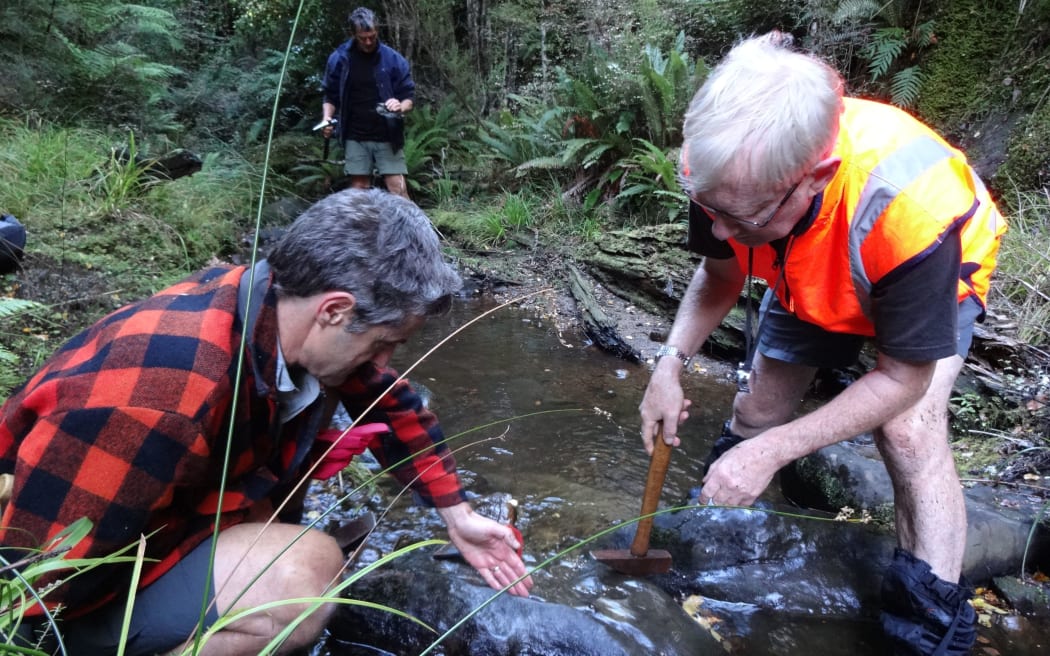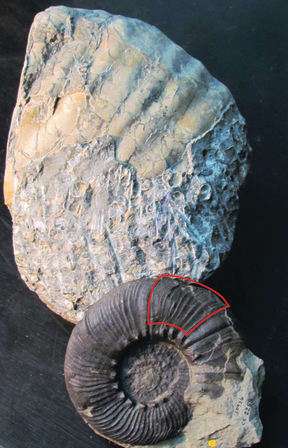Palaeontologists have unearthed one of the largest ammonites found in New Zealand during an informal fossil hunting field trip in Hawke's Bay.
The find came when GNS Science palaeontologist James Crampton and collections manager John Simes were exploring the Waiau River, which runs along the boundary of the Maungataniwha Native Forest in inland Hawke's Bay.
They were scouring the loose boulders and stream bed for small clams and snails when Mr Simes stumbled over a fossil much bigger in size.
About 90 centimetres in diameter, the ammonite he discovered is among the largest ever seen in New Zealand. It was embedded in geological layer that was put down about 85 million years ago, when dinosaurs roamed the forests and the oceans.

GNS Science palaeontologists James Crampton, left, and John Simes. Pete Shaw, behind, is from the Forest Lifeforce Restoration Trust. Photo: RNZ / Veronika Meduna
"This came as a complete surprise to us," said Mr Crampton.
"We don't have a significant record of ammonites in New Zealand so this find adds considerably to what we know about palaeontological history and about what was living here at that time."
Creatures from the past
Ammonites were predatory, squid-like creatures of the ancient oceans. They lived inside the outer-most chamber of their spiralled shell, and pumped the smaller chambers with fluid or gas to control their buoyancy. They could sink like a stone to escape predators, or scoot through the warm seas in pursuit of small fish and crustaceans.
Ammonites thrived around the same time as dinosaurs and disappeared with them during the same extinction event.
The largest fossil specimen discovered in New Zealand, also the third-largest worldwide, measures 1.42 metres across and is now on display in Te Papa.

The giant Maungataniwha fossilised ammonite (rear), compared against a smaller, complete ammonite fossil which is 165mm in diameter. The area outlined in red on the smaller specimen indicates the section discovered at Maungataniwha. Photo: SUPPLIED
While ammonites are relatively common elsewhere, they are very rare in New Zealand for reasons not yet completely understood.
"This may help us understand more about why ammonites were so seemingly rare here when they appear to have been so common in other places. Even back then, it would seem, there was something unusual about New Zealand's marine environment," Mr Crampton said.
The field trip was revisiting the region where celebrated palaeontologist Joan Wiffen discovered her first fossil of a land-dwelling dinosaur during the 1970s.
James Crampton said the surprise find demonstrated just how much more there was to be discovered in New Zealand's rich but under-explored fossil record.
Mr Crampton said the Waiau River bed was a palaeontologist's dream because it had carved its way through a succession of geological layers.
"Walking along the Waiau is like walking back in time. In geological terms it takes us deeper and deeper below the earth's surface, without having to dig an inch."
He expects the area to hold more secrets.
"If we can wander randomly up a streambed and pick up a fossil of this significance, in the same way as Joan Wiffen did all those years before us, imagine what we'll unearth when we really start looking."
The next task is to attempt to remove the entire fossil from the 50kg boulder it is embedded in so that GNS Science can put it on display at its offices in Lower Hutt.
Preserving the kakabeak plant
The Maungataniwha Native Forest is owned by the Forest Lifeforce Restoration Trust which has made it one of its goals to increase the number of native plants and animals, including one of New Zealand's rarest flowering plants, the kakabeak.

Lunch spot in a dinosaur forest: GNS Science palaeontologists John Simes and James Crampton and Forest Lifeforce Restoration Trust land manager Pete Shaw take a break from the hard work involved in hunting for fossil bones. Photo: RNZ / Veronika Meduna

